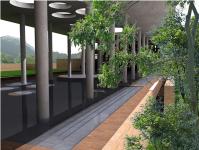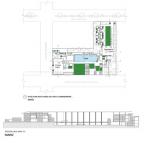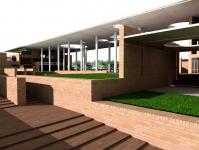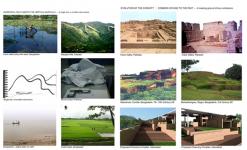Evolution of the Concept
¬¬¬
Common Voyage to the Past - A meeting ground of two civilizations
Pakistan having the history of around 5000 years old Indus Valley civilization and Bangladesh having the history of around 3000 years old Bengal civilization has a common voyage to the past. The resemblance between Bangladesh and Pakistan is the historical ruins of Buddhist civilization, particularly the terracotta brick ruins of both lands make it a common ground for the design. This inspired us to use this phenomenon as “typology” to develop the site as an “archeological Landscape”, a meeting ground for two civilizations.
Horizontal Delta Meets Vertical Margalla - A single line, a humble intervention
The concept of the project has evolved with a single horizontal line representing the land of Bangladesh against the vertical majestic Margalla Hills of Pakistan as a tender intervention.
Bangladesh, the largest delta on earth having water in abundance with flatness of the land and Pakistan having a contoured land with range of mountains in Islamabad played the key role in setting up our whole design. Large water body as “delta” with flat long rectilinear parasol roof as “Jali” representing the flat humble landscape of Bangladesh looking at the regal stunning Margalla Hills is complimentary to each other.
Design Consideration
Geography and Climatology
The city of Islamabad is situated at the edge of the Pothohar Plateau, south of Margalla Hills. The modern capital city Islamabad and the ancient Gakhar city of Rawalpindi stand side by side, displaying the country’s past and present. The area’s micro climate is regulated by three man-made lakes Rawal, Simli and Khanpur. The city over all has an extreme climate with hot summer with monsoon rain occurring during July and August, and fairly cold winter with sparse snowfall over the hills and sleet in the city. The weather ranges from a minimum of -3.9 degree C in January to maximum 49 degree C in June.
Structural System
Keeping the fact that Islamabad is potentially an earth quake zone a simple grid of 22 feet by 22 feet has been selected for the design. Also, the structural design has been developed respecting the local construction system.
For this, basically 18x18 inches and 10x18 inches concrete columns with 24x10 inches beam structure have been used. Here concrete block cavity walls between columns have been used. Adding 2 inches exterior terracotta cladding totaling approximately 21 inches or 13 inches walls (basically these two types of wall as exterior walls) are the basis for the overall design. The “Jali roof” or parasol with approximately sixteen inches thick slab is supported by the circular columns of 25 inches diameter with numbers of circular punches.
Use of Material - A link between climate and history
The hot and dry climate of Islamabad in summer with low humidity and rather cold winter requires special consideration. Simultaneously considering the use of bricks in both the Indus civilization of Pakistan and the Bengal civilization is another consideration for the scheme. So, the C.C block wall with cavity and cladding brick as infill with R.CC structural column support is suggested to achieve the relatively comfortable interior. Here the use of locally available facing brick with increased thickness justifies the archeological ambience linked to the past.
Soil Condition and Vegetation
The overall soil, except a layer of fertile top reddish soil, is good for the 30 to 40 feet tall trees and shrubs. The rock is the basic formation of the soil underneath. For this reason Islamabad grows green trees mostly with the moderate height plants such as Acacia, cassia fistula, delonix regia (Krisnachura), apocynaceae(chatim), Jhao etc.. Therefore, these kinds of vegetation have been used in the proposed scheme.
SUSTAINABILITY: Cost Economy and Ecology
Rainwater Harvesting
As the use of water plays a vital role in the overall
2008
Bangladesh Chancery Complex by Rafiq Azam in Pakistan won the WA Award Cycle 5. Please find below the WA Award poster for this project.
.jpg&wi=320&he=452)
Downloaded 745 times.
Favorited 4 times
a(2).jpg)
.jpg)
a(2).jpg)
.jpg)
.jpg)
.jpg)


(1).jpg)


